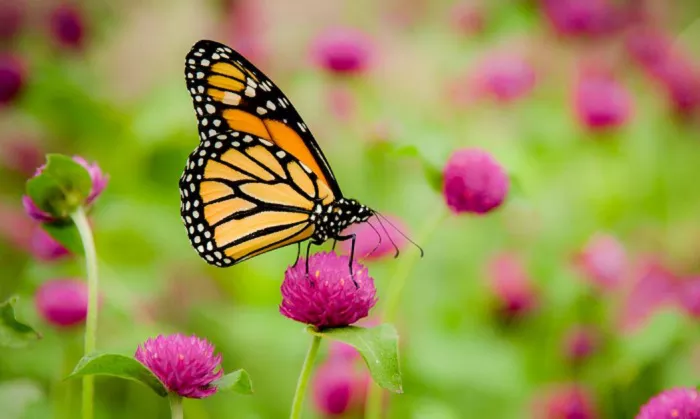Butterflies are more than just delicate winged wonders; they play a crucial role in pollination. Their colorful presence in gardens and meadows is a testament to nature’s intricate balance. As they flit from flower to flower, butterflies transfer pollen, aiding in the reproduction of numerous plants. Understanding which plants they pollinate can enhance our gardens and support biodiversity. This article explores the fascinating relationship between butterflies and the plants they favor, offering insights for gardeners and nature enthusiasts alike.
The Allure of Butterfly-Pollinated Plants
Butterflies are selective in their choice of plants, often drawn to those with bright colors and sweet fragrances. These plants have evolved to attract butterflies with their nectar-rich flowers, creating a mutually beneficial relationship. The vibrant hues of butterfly-pollinated plants not only add beauty to our landscapes but also serve as a beacon for these winged visitors.
A Feast of Colors and Fragrances
Butterfly-pollinated plants typically exhibit a range of bright colors, including reds, pinks, yellows, and purples. These colors are like a neon sign for butterflies, guiding them to their nectar sources.
Additionally, many of these plants emit a sweet fragrance that further entices butterflies. The combination of visual and olfactory cues ensures that butterflies are attracted from a distance, increasing the likelihood of successful pollination.
The Role of Flower Shape
The shape of a flower also plays a significant role in attracting butterflies. Many butterfly-pollinated flowers have a flat or tubular structure, allowing butterflies to land easily and access the nectar. Flowers with a landing platform provide a convenient perch for butterflies, enabling them to feed without expending too much energy. This design is particularly beneficial for species with shorter proboscises, as it allows them to reach the nectar more efficiently.
Native Plants and Butterfly Pollination
Native plants are essential for supporting local butterfly populations. These plants have co-evolved with butterflies over thousands of years, creating a symbiotic relationship that is vital for both parties. Native plants are often more resilient to local pests and diseases, making them a reliable food source for butterflies. Additionally, they provide habitat and breeding grounds for many butterfly species.
Milkweed: A Butterfly Favorite
Milkweed is perhaps the most well-known plant associated with butterflies, particularly the iconic monarch butterfly. Monarch caterpillars rely exclusively on milkweed as their food source, and adult monarchs often return to milkweed plants to lay their eggs. The nectar-rich flowers of milkweed also attract a variety of other butterfly species, making it a cornerstone of any butterfly-friendly garden.
Coneflowers and Their Butterfly Appeal
Coneflowers, or Echinacea, are another excellent choice for attracting butterflies. These native plants produce large, daisy-like flowers with a prominent central cone. The flowers’ bright colors and abundant nectar make them irresistible to butterflies. Coneflowers are also drought-tolerant and easy to grow, making them a practical addition to any garden.
Garden Plants and Butterfly Pollination
In addition to native plants, many garden plants are also effective at attracting butterflies. These plants can be incorporated into a garden design to create a vibrant and pollinator-friendly landscape. By choosing the right plants, gardeners can support butterfly populations while enjoying the beauty of these winged visitors.
Butterfly Bush: A Magnet for Butterflies
The butterfly bush, or Buddleia, is aptly named for its ability to attract a wide variety of butterflies. This fast-growing shrub produces clusters of fragrant flowers in shades of purple, pink, and white. The flowers’ tubular shape and abundant nectar make them a favorite among butterflies.
However, it is important to note that some species of butterfly bush can be invasive in certain regions, so gardeners should choose native or non-invasive cultivars.
Zinnias: A Colorful Butterfly Attraction
Zinnias are another popular choice for butterfly gardens. These annual flowers come in a wide range of colors and sizes, making them versatile additions to any garden. Zinnias produce large, flat flowers that provide an excellent landing platform for butterflies. Their bright colors and sweet nectar make them highly attractive to a variety of butterfly species, including swallowtails and painted ladies.
The Importance of Diverse Plantings
Creating a diverse garden with a variety of plants is essential for supporting butterfly populations. Different butterfly species have unique preferences for nectar sources, so including a mix of plants ensures that a wide range of butterflies will be attracted.
Additionally, diverse plantings provide habitat and food sources for other pollinators, such as bees and hummingbirds, creating a thriving ecosystem.
Succession Planting for Continuous Bloom
To keep butterflies coming to your garden throughout the season, consider succession planting. By staggering the planting of different flowers, you can ensure a continuous supply of nectar for butterflies. Choose plants with different bloom times, such as early-season flowers like lilacs and mid-season flowers like black-eyed Susans, followed by late-season bloomers like asters. This approach ensures that butterflies always have a source of food, encouraging them to stay in your garden.
Providing Shelter and Breeding Grounds
In addition to nectar sources, butterflies also need places to rest and breed. Incorporating plants with dense foliage or providing small piles of leaves and twigs can create sheltered areas for butterflies to rest and hide from predators. For species that lay eggs on specific plants, such as monarchs on milkweed, including these host plants in your garden is crucial for supporting their life cycle.
Conclusion
Butterflies are not only beautiful additions to our gardens but also vital pollinators that support plant reproduction and biodiversity. By understanding the plants they pollinate, we can create gardens that attract and support these delicate creatures.
Whether through native plants like milkweed and coneflowers or garden favorites like butterfly bush and zinnias, every plant plays a role in this intricate dance of nature. Embracing diversity and providing continuous blooms and shelter can transform any garden into a haven for butterflies, enriching both our landscapes and the natural world.


